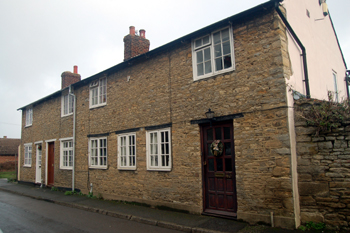39 to 43 Silver Street Stevington

39 to 43 Silver Street December 2009
39 to 43 Silver Street were listed by the former Department of Environment in June 1974 as Grade II, of special interest. The Department dated the buildings to the 19th century and, like many of the older buildings in the area they are constructed of coursed limestone rubble, though with cement rendering to the gable ends. They have two storeys beneath a Welsh slate roof.
The Rating and Valuation Act 1925 specified that every building and piece of land in the country was to be assessed to determine its rateable value. Stevington was assessed in 1926 and the valuer visiting 39-43 Silver Street [DV1/C120/61-65] found a different group of houses to those surviving today. At that date a terrace of six houses stood here. The dwelling at the north-east end of the block has since been demolished and the remaining dwellings altered, as is clear by the present [2009] asymmetrical facades. The terrace was owned by a Mrs. Prentice in 1926.
The house which has now gone was occupied by W. Saunders and had two bedrooms. The other properties, running south-west were: a one bed cottage occupied by P. Cox at a rent of two shillings per week; a two bed cottage occupied by W. Ruffhead at a rent of 2/1 per week; a two bedroom cottage occupied by A. Aspley at a rent of 2/1 per week; a two bedroom cottage occupied by Mrs. Church at a rent of 2/1 per week and a two bedroom cottage occupied by F. Goldsmith at a rent of 2/1 per week. All the cottages in the row had a living room and kitchen downstairs with a barn and earth closet outside.
It seems likely that one of the Stevington casualties of the Great War lived here - Lance Corporal Henry George Aspley, son of Alfred Aspley of Silver Street was killed with the 7th Bedfords on 8th January 1916.